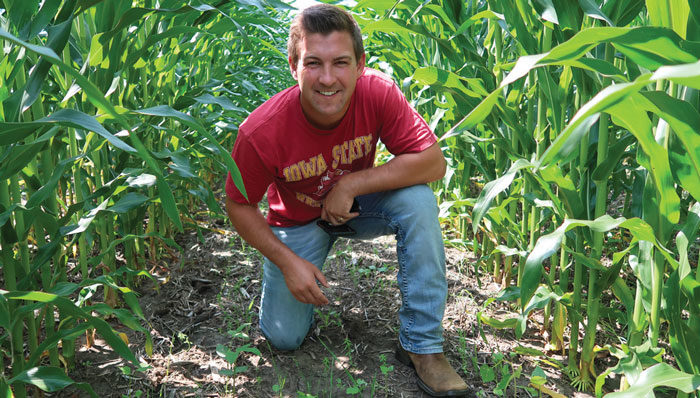No-tillers who are growing corn have an excellent opportunity to cash in on government demands to reduce the overall carbon intensity of the biofuels industry. The Inflation Reduction Act, passed in 2022, includes the 45Z tax credit to incentivize the production of clean fuel. Beginning Jan. 1, 2025, the new credit will reward renewable fuel producers for lowering the carbon intensity (CI) score of their fuel. The tax credit for the ethanol plants could mean additional income for no-tillers with low CI scores, as 40% of the U.S. corn crop goes into ethanol production.
On April 30, 2024, the federal government released an updated version of the Greenhouse Gases, Regulated Emissions and Energy Use in Transportation (GREET) model, called the 40B SAF-GREET 2024 model, which is used to determine CI scores of sustainable aviation fuel (SAF) feedstocks.
Washington, Iowa, no-tiller Mitchell Hora is the founder of Continuum Ag. The soil health data intelligence company developed software that automates the GREET model to calculate a farm’s CI score. Hora shares his 7 key takeaways from the updated GREET model:
1. Indirect Land Use Change (ILUC): “There was a huge unexpected positive outcome regarding ILUC in the IRS Rules. I was anticipating that the ILUC factor (historically 7.4CI points US corn-based ethanol) would go up by 5 points or worse. Luckily, this was not the case and corn-based ethanol shows a lot of promise in the future of sustainable fuels.
2. Feedstock Calculator: “Unfortunately, we haven’t seen an update to the GREET feedstock calculator. This absence raises concerns, especially considering its significance in quantifying the carbon intensity score of various feedstocks. While it’s disappointing, it highlights the urgency of advocating for its release before the implementation of 45Z. Our industry relies heavily on accurate data and tools, and the absence of an updated calculator presents a significant challenge that we must address collectively. “In lieu” of using the GREET feedstock calculator, the 40B rules used a ‘punt’ approach and are allocating a simple 10 CI point reduction for farms using cover crop, no-till, and enhanced efficiency fertilizer. They grant a 5 CI point reduction for soybean producers using cover crops and no-till. Hopefully 45Z will use the real CI reduction rather than this oversimplified approach.
WATCH: Mitchell Hora hosts a webinar about the updated 40B SAF-GREET model for calculating CI
scores, and breaks down what it means for 45Z.
3. Definitions of Climate-Smart Ag Practices: “On a positive note, we’ve received clear definitions of climate-smart ag practices. While this doesn’t compensate for the lack of a feedstock calculator update, it provides valuable guidance for farmers. Cover crop, no-till, and enhanced efficiency fertilizers are highlighted as key practices to be deemed climate smart.
- Cover Crop: “The base rules go with flexibility toward cover crop species and planting/termination timing, as long as the farmer adheres to NRCS guidelines. Options for interseeding, companion cropping, haying and grazing exist, but harvesting covers for seed is restricted.
- No-Till: “Per these new rules, no-till doesn’t necessarily mean no tillage. Per the guidance, no-till now includes leaving residue evenly distributed over soil surfaces, with exceptions for the planting furrow (aka strip-till is fine). Burning residue is prohibited.
- Enhanced Efficiency Fertilizer: “This practice requires the use of stabilizers on at least 50% of nitrogen content, with a written plan for NPK management. Approved stabilizers have to be used and we are researching these university derived lists now.
4. Mass Balancing for Traceability: “The unexpected emphasis on traceability by the IRS caught many by surprise. However, the guidelines laid out provide a solid framework for ensuring the accountability of climate-smart grains in sustainable aviation fuel production. By tracking the movement of loads and maintaining detailed documentation, the traceability of climate-smart grains throughout the supply chain is ensured. Additionally, the requirement for each entity storing grain to conduct its own mass balance equation ensures transparency and accountability at every stage of the process. I need to learn a lot more in this arena, but the rules appear promising.
5. Restrictions on Stacking Carbon Outcome Programs: “Another unexpected development was the IRS’s stance on stacking carbon intensity programs with other carbon credit programs. While this may come as a disappointment to some, it clarifies the boundaries between different types of carbon initiatives. The IRS laid out a “farmer attestation” document (we anticipated needing one of these and have been working on it for months) but the farmer must also attest that they are not in any other carbon programs. Although it would have been nice to stack, I wasn’t confident the IRS would allow for it, now we have clarity.
6. Other CI-Reducing Pathways: “The 40B GREET model introduces various pathways for reducing carbon intensity beyond purchasing low-carbon feedstock. From carbon capture and storage (CCS) to utilizing renewable energy systems, there are numerous avenues available for reducing carbon intensity scores. While the impact of on-farm practices may not be as significant in this version of the GREET model, it highlights the importance of exploring diverse strategies to achieve carbon intensity reductions. This is the first time that the IRS is using the GREET model for tax credit purposes and the first time that the government is directly rewarding the noted soil health practices as part of their climate goals.
7. Preparation for 45Z: “As we navigate through the intricacies of the 40B rules and GREET updates, it’s important to keep our sights set on the implementation of 45Z. With its rollout coming soon, we must take proactive measures by knowing your CI Score and organizing/verifying your data to make sure the opportunity is maximized.”
With 45Z, Hora believes corn growers have an unprecedented opportunity to share in what many would term an industrial tax credit windfall.
“This is one of today’s biggest opportunities in ag — particularly conservation ag,” he says. “The folks with data — the agronomist, the team around each farmer — we all need to be working together with the folks at the biofuel facility to go after these credits together. Let’s maximize this opportunity and make certain we have an equitable share of those dollars throughout the ag supply chain, with farmers who are contributing getting paid their fair share.”
The big influencers for lowering a crop’s CI include cover crop use, reduced tillage or no-till, nitrogen fertilizer use, field-by-field yield figures, diesel fuel consumption throughout the crop’s season and overall energy use. These practices likely sound familiar to no-tillers using them to build soil health and lower costs — and an operation’s carbon footprint.
“We need to document all of these practices to determine — and lower — our production CI score,” Hora says. “The better the score, the more you help the biofuel company meet its goals, the more credits it can earn, and the more money they could pass along to you. When an ethanol plant buys our family’s corn to produce ethanol, we are selling them carbon-negative corn, which offsets the plant’s carbon footprint. Now they are producing very low CI-score ethanol, which qualifies for the 45Z tax credit of $0.02 per gallon per CI point reduction.”
The corn on Hora's family farm has a CI score of -10, which is likely worth $500 an acre growing 240-bushel yields.
“That’s the total pie,” he says. “I’m not going to get $500 per acre, and the ethanol guy is not going to get $500 per acre. But if we aren’t willing to negotiate, neither of us will get anything.”
At 250 bushels per acre, $500 indicates a “pie” of $2 per bushel, Hora says.
“I don’t know what my cut is going to be,” he says. “I don’t think I should get 10 cents, and I don’t think I’m going to get $1.90, but it will be somewhere in the middle.”
Related Content
Low-Carbon Corn Could Yield Serious Cash for No-Tillers
[Podcast] Carbon-Negative Corn, Weekly Soil Sampling & More with Mitchell Hora of Continuum Ag
Continuum Ag's Billion Bushel Challenge Raises Awareness about Low-Carbon Corn









Post a comment
Report Abusive Comment